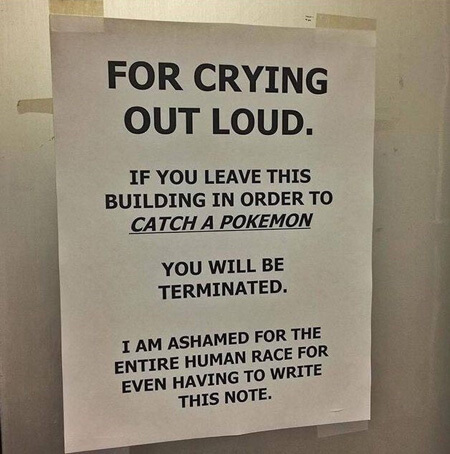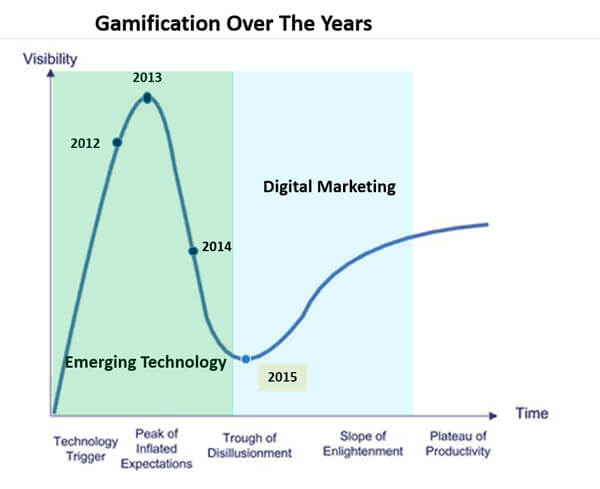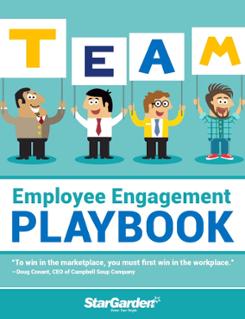Do you Need an HR Policy for Employees’ Video Game Habits at Work?

Recently, the internet has been bombarded with Pokémon Go memes. Some hilarious, others less so. One that really caught my eye was where a distraught manager posted this notice.

While the scenario was met with laughs and other reactions, consider what your stance would be?
Per Gallup studies, only 31% of the work force is engaged. In the midst of low employee engagement levels, are games like Pokémon Go just another distraction or is it something you can utilize to improve employee morale or incorporate into your hiring procedures?
To put things in perspective, consider the fact that HR gamification is not new. Incorporating games into work goes back to a time when ancient Egyptian workers turned pyramid-building into a sport1. Every year, Gartner has been tracking gamification and incorporating it in its hype cycle. Until 2014, it was listed as an emerging technology when they finally switched it to digital marketing as many companies used it for driving customer loyalty campaigns. But aren’t employees your internal customers and need the same type of engagement too?

Pic Information Source: Gartner reports
It’s a known fact that millennials play video games and are actively engaged in online gaming of some kind. Given that more than 50% of the world’s workforce is going to include millennials, it is understandable that as a manager, you have to decide what your stance on the use of gamification technologies is.
Based on your organization’s culture you may:
- Allow it while not actually being on board with it: This is you being okay with your employees taking a break now and then to go catch their Pokémons or check their alerts
- Disallow it: Some managers around the world have already made a name for themselves online by threatening citations and disciplinary actions for employees leaving work to play
- Actively utilize it for employee engagement and recruiting practices: Organizations like PwC have been using gamification for the recruiting and interviewing process for a while [2]. Some companies have specific areas that incorporate Wii or play stations where employees socialize over their favorite virtual reality sport. Others create teams to invoke healthy competition in the work place and use it for team building exercises.
Before you decide, you should understand what gamification is: It is the application of behavior-motivating techniques from traditional and social games to non-game environments [3].
Here are three ways gamification can be used by HR:
- Recruiting: Depending on how and what you choose to test your future employees on, you can use one of the online or specifically designed in house games to evaluate prospective candidates. Government organizations like US National Geospatial Intelligence Agency and the US Federal Bureau of Investigation routinely use it in their hiring processes. The main advantage of online games is that it allows you to evaluate a candidate’s job performance in a controlled environment before hiring. It can indicate how someone makes decisions with limited information in a time crunch or how quickly someone learns and thinks. When having team based competitions, it can show how well they interact with others
- Team building exercises: Using team challenges can be another tool for you to have your employees work together while enjoying a healthy competition.
- Employee wellness programs: Using wearables that track fitness and walking, you can easily have workweek challenges that both motivate your employees to walk more. Sitting at a desk is related to so many diseases, pitting teams against each other might be the push your employees need to walk more and get healthy.
Just like bring your own device, allowing pets, or telecommuting policies, gamification technology and its use is something that needs your consideration. After all it is something your employees care about.
It’s an exciting time to be in HR with more digital ways to enhance engagement. Understand the various ways to engage your employees in our Free Employee Engagement Playbook!
References:
- http://www.bbc.com/capital/story/20160728-the-people-who-play-pokemon-go-at-work-with-the-bosss-ok
- http://www.forbes.com/sites/jeannemeister/2015/03/30/future-of-work-using-gamification-for-human-resources/#191c88e132ba
- http://humanresources.about.com/od/employeerecognition/qt/5-ways-gamification-can-improve-hr-management.htm

